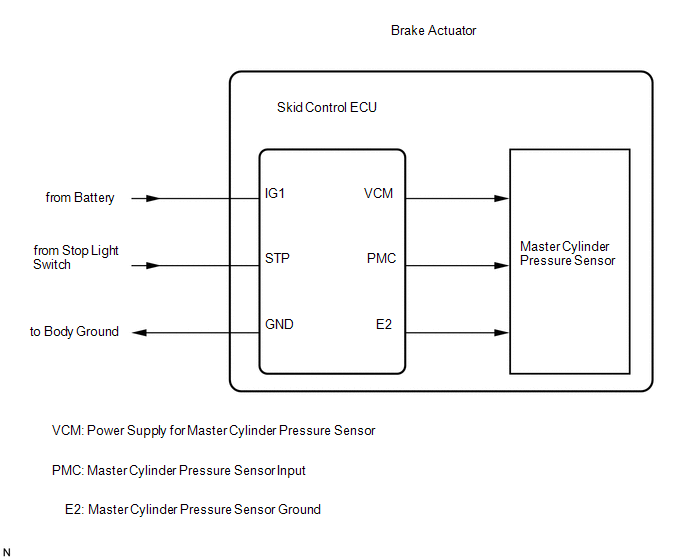Toyota Venza: Master Cylinder Pressure Sensor Malfunction (C1246/46,C1281/81)
DESCRIPTION
Master cylinder pressure sensor is connected to the skid control ECU in the brake actuator assembly.
DTC C1281/81 will be cleared when the master cylinder pressure sensor sends a master cylinder pressure signal or when Test Mode ends. DTC C1281/81 is output only in Test Mode.

|
DTC Code |
DTC Detection Condition |
Trouble Area |
|---|---|---|
|
C1246/46 |
Any of the following is detected:
|
|
|
C1281/81 |
Detected only during Test Mode. |
|
WIRING DIAGRAM
Refer to DTC C1249/49 (See page .gif) ).
).
PROCEDURE
|
1. |
CHECK STOP LIGHT OPERATION |
(a) Check that the stop light comes on when the brake pedal is depressed, and goes off when the brake pedal is released.
OK:
|
Condition |
Illumination Condition |
|---|---|
|
Brake pedal depressed |
ON |
|
Brake pedal released |
OFF |
| NG | .gif) |
INSPECT STOP LIGHT CIRCUIT |
|
|
2. |
READ VALUE USING TECHSTREAM (MASTER CYLINDER PRESSURE SENSOR) |
(a) Connect the Techstream to the DLC3.
(b) Start the engine.
(c) Select the Data List on the Techstream (See page
.gif) ).
).
ABS/VSC/TRAC
|
Tester Display |
Measurement Item/Range |
Normal Condition |
Diagnostic Note |
|---|---|---|---|
|
Master Cylinder Sensor |
Master cylinder pressure sensor reading / Min.: 0 V, Max.: 5 V |
Brake pedal released: 0.3 to 0.9 V |
Reading increases when brake pedal is depressed |
(d) Check that the brake fluid pressure value of the master cylinder pressure sensor observed on the Techstream changes when the brake pedal is depressed.
OK:
When the pedal is depressed, voltage displayed on the Techstream increases.
| NG | .gif) |
REPLACE BRAKE ACTUATOR ASSEMBLY |
|
|
3. |
READ VALUE USING TECHSTREAM (STOP LIGHT SWITCH) |
(a) Select the Data List on the Techstream (See page
.gif) ).
).
ABS/VSC/TRAC
|
Tester Display |
Measurement Item/Range |
Normal Condition |
Diagnostic Note |
|---|---|---|---|
|
Stop Light SW |
Stop light switch / ON or OFF |
ON: Brake pedal depressed OFF: Brake pedal released |
- |
(b) Check that the stop light condition observed on the Techstream changes when the brake pedal is depressed.
OK:
When the brake pedal is depressed, the Techstream displays "ON".
| NG | .gif) |
GO TO STEP 5 |
|
|
4. |
RECONFIRM DTC |
(a) Turn the ignition switch off.
(b) Clear the DTCs (See page .gif) ).
).
(c) Start the engine.
(d) At a speed of 30 km/h (18 mph) or more, drive the vehicle and perform braking test (decelerate the vehicle by depressing the brake pedal).
(e) Check if the same DTC is recorded (See page
.gif) ).
).
|
Result |
Proceed to |
|---|---|
|
DTC (C1246/46) is not output |
A |
|
DTC (C1246/46) is output |
B |
| A | .gif) |
CHECK FOR INTERMITTENT PROBLEMS |
| B | .gif) |
REPLACE BRAKE ACTUATOR ASSEMBLY |
|
5. |
INSPECT SKID CONTROL ECU (STP TERMINAL) |
|
(a) Turn the ignition switch off. |
|
(b) Make sure that there is no looseness at the locking part and the connecting part of the connector.
(c) Disconnect the skid control ECU connector.
(d) Measure the voltage according to the value(s) in the table below.
Standard Voltage:
|
Tester Connection |
Switch Condition |
Specified Condition |
|---|---|---|
|
A42-30 (STP) - Body ground |
Stop light switch ON (Brake pedal depressed) |
8 to 14 V |
|
A42-30 (STP) - Body ground |
Stop light switch OFF (Brake pedal released) |
Below 1.5 V |
|
*1 |
Front view of wire harness connector (to Brake Actuator (Skid Control ECU)) |
| OK | .gif) |
REPLACE BRAKE ACTUATOR ASSEMBLY |
| NG | .gif) |
REPAIR OR REPLACE HARNESS OR CONNECTOR (STP CIRCUIT) |
 Open in Stop Light Switch Circuit (C1249/49)
Open in Stop Light Switch Circuit (C1249/49)
DESCRIPTION
The skid control ECU (housed in the actuator assembly) inputs the stop light
switch signal and the condition of brake operation.
The skid control ECU has an open detection circuit, whi ...
 Speed Sensor Rotor Faulty (C1237/37,C1275/75-C1278/78)
Speed Sensor Rotor Faulty (C1237/37,C1275/75-C1278/78)
DESCRIPTION
The skid control ECU measures the speed of each wheel by receiving signals from
the speed sensor.
These signals are used for recognizing that all four wheels are operating properly.
T ...
Other materials about Toyota Venza:
Installation
INSTALLATION
PROCEDURE
1. INSTALL FRONT SUSPENSION MEMBER BODY MOUNTING REAR CUSHION LH
(a) Temporarily install a new front suspension member body mounting rear
cushion LH while confirming the installation direction.
NOTICE:
Position th ...
Check Mode Procedure
CHECK MODE PROCEDURE
1. DESCRIPTION
(a) Check mode has a higher sensitivity to malfunctions and can detect malfunctions
that normal mode cannot detect. Check mode can also detect all the malfunctions
that normal mode can detect. In check mode, DTCs are d ...
Vehicle Speed Sensor Malfunction (P0500)
DESCRIPTION
The vehicle speed sensors detect the wheel speed and send the appropriate signals
to the skid control ECU. The skid control ECU converts these wheel speed signals
into a 4-pulse signal and outputs it to the ECM via the combination meter assemb ...
0.1293

.gif)
.png)